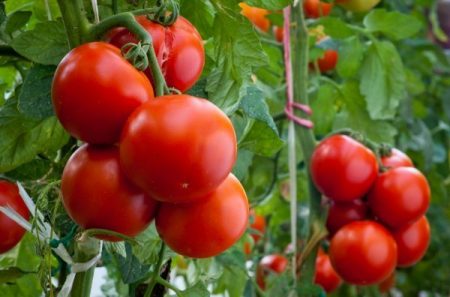 Late blight is considered a very dangerous disease, which affects tomatoes of various varieties. Even the most persistent fruits are prone to late blight. Moreover, the connection occurs when humidity reigns in the atmosphere, which provokes the appearance of brown spots. Also, gardeners noticed that the tomatoes were affected due to the sharp temperature difference.
Late blight is considered a very dangerous disease, which affects tomatoes of various varieties. Even the most persistent fruits are prone to late blight. Moreover, the connection occurs when humidity reigns in the atmosphere, which provokes the appearance of brown spots. Also, gardeners noticed that the tomatoes were affected due to the sharp temperature difference.
Recently, an interesting fact has been established that fungi can infect soil and seeds. Therefore, it is necessary to process the seeds before planting. This will help eradicate soil diseases. Now you understand why tomatoes, both resistant to late blight and growing in a greenhouse, are of great interest to all gardeners.
Varieties of tomatoes for greenhouses and late blight resistant fruits can be different, it all depends on the terrain and conditions. Tomatoes in greenhouses can be found in short and cold summers. But few people know what exactly hybrid varieties need to be planted.
Character traits
Excellent varieties of tomatoes and late blight resistant for the Moscow region will be described at the end of the article. Now is the time to deal with what is late blight. Tomatoes are most often susceptible to diseases of this type. Fungi become the cause of the disease.
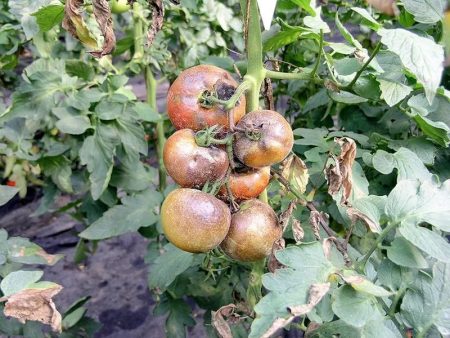
First, rot appears, which affects the leaves, then the fruits themselves. This disease is easily recognized by dark spots that spread throughout the bush in 2-3 days. Usually, gardeners notice how tomatoes are affected by the end of the summer season. If the weather is wet, then spots may appear much earlier.
Important! Tomatoes that are not afraid of late blight are early-ripening and hybrid varieties that manage to ripen before the onset of the disease.
What causes late blight?
In greenhouse fruits, dark spots appear when there is not enough air. This becomes the main and, perhaps, the main factor to pinch the plant. Rain and cold create optimal conditions for the development of the disease. Seeds for open ground should be selected carefully, since it is under such conditions that tomatoes are affected more than in greenhouses.
Important! Remember that the fungus is brought from potato beds, therefore, these two crops should not be nearby.
Dark spots appear:
• due to the abundant application of nitrogen fertilizers;
• due to dense landing;
• due to lack of manganese or potassium in the soil;
• due to weed growth.
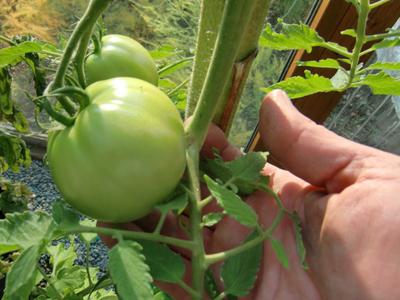
Hot weather can stop the epidemic. As we already said, the disease can be easily recognized by dark spots. But there are still signs that indicate the development of late blight. For example, if the disease has overtaken a plant earlier, then it will be possible to notice how the inflorescences dry out every day. Unfortunately, the disease progresses very quickly, so measures must be taken as soon as possible. Also worth process the greenhouse from late blight before planting plants.
Symptomatology
Blight is easy to recognize. The disease can affect the entire bush or only part.
1. At the tips or edges of the leaves you can see green spots with a grayish tint. If the humidity does not go away, then the lower part is covered with a gray coating, similar to mold. Every day, the leaves will darken and die.
2. You can also notice how the stems have turned brown. Every day you watch how your plant dies.
3. Brown spots appear on the fruit, which harden. The fruits are separated from the stem and fall to the ground.

Watch for these signs. If you notice at least one symptom, then know your plant is sick!
What kind of late blight is it?
There are various varieties of tomatoes resistant to late blight. You will see their description below.Usually advised to purchase precocious varieties. They are particularly resistant. The longer the bushes develop, the more fruits do not have time to ripen, and those that have managed to spoil.
Choosing the best fruits that are not afraid of late blight, often have to experimentally. Many gardeners decide on a desperate step and plant only early ripening hybrids, in the hope that they will harvest before the epidemic. Now we indicate tomato varieties resistant to late blight.
Tomatoes that are not affected by late blight:
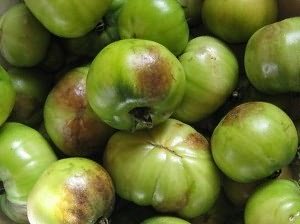 1. First of all, this is an early ripe variety "Gnome". It is recommended to be planted in open ground.
1. First of all, this is an early ripe variety "Gnome". It is recommended to be planted in open ground.
2. Also for planting in open ground, the following variety is suitable - "Alpateva".
3. Not quite early, but nevertheless, the Budenovka variety belongs. These tomatoes can be grown both in greenhouses and in open ground.
4. Not early ripe, but resistant to the disease, include variety of tomatoes "De Barao". It can be planted in open ground and in greenhouses.
5. Early ripening variety “Lark” is also resistant to late blight. It has very tasty and sweet fruits.
6. The next high-yielding and early variety is considered “Dubrava”. This plant is grown in open ground.
7. “La-la-fa” grows well in open ground and in greenhouses. Such tomatoes are classified as hybrid varieties.
8. “Union” is intended for any type of use. This is an early ripe variety.
9. There are two more stable varieties - “Peter and Blizzard”. They are grown in greenhouses and in open ground.
Now you know which varieties of tomatoes do not suffer from late blight. Of course, no one is completely insured and this is not 100%, but nevertheless the stability of hybrids is several times higher than other fruits. It's time to consider in more detail all of the listed varieties with the main characteristics.
Table number 1
| Plants with small bushes | |
| Title | Characteristic |
| Dubrava | These tomatoes are representatives of a stunted plant (reach a height of up to 60 cm); fruits are tied in 2.5 months; red and sweet tomatoes; a distinctive sign is a greenish speck near the stalk. |
| Resonance | It should be noted here that plant growth does not stop during the entire development; 3 months after germination, you can harvest; the plant reaches 120 cm in height; the fruits of this variety are round in shape and have a red color; the plant grows well during periods of severe drought and tolerates transportation well. |
| Gnome | This variety is considered universal; the plant begins to bear fruit after 3 months; bushes reach a height of up to 45 cm; the weight of one fruit reaches 60 grams; at a time from one bush you can collect up to 3 kilograms. |
| Orange miracle | Tall bushes; the crop can be harvested after 2.5 months; the fruits are large and flat; tomatoes are orange in color, which indicates a large amount of carotene; the weight of one fruit can reach 400 grams; This variety tolerates heat very well. |
| Perseus | Early ripe variety; the height of one bush can reach 70 cm; Harvest after 4 months; the weight of one fruit reaches 120 grams; This variety tolerates transportation well, which means it can be stored for a long time. |
Table number 2
| Varieties designed for greenhouses | |
| Title | Characteristic |
| Tatyana | This plant requires a garter; Harvesting is possible after 3.5 months after germination; bushes erect and strongly branched; the bush is capable of reaching a height of up to 60 cm; good fleshy tomatoes and flat-round; the color is red, if the tomato is not ripe, then it will have a dark green color; one fruit reaches 120 grams in weight. |
| De Barao (black) | Tall plant; bushes reach 2 meters in height; Harvest after 3 months; dark cherry tomatoes; the weight of one fruit = 80 grams; from one bush you can collect up to 5 kilograms. |
| Cardinal | This variety is loved by many gardeners; the height of the bushes reaches 2 meters; the fruits have a bright raspberry color; tomatoes are heart-shaped; tomatoes can gain weight in 500 grams and more; the plant requires regular watering and top dressing. |
What varieties to choose?
Most gardeners prefer hybrid Dutch varieties. They believe that these plants are more resistant to late blight. But domestic varieties also turn out to be attractive, since there is the opportunity to choose the option for yourself.Still, domestic plants are adapted to local conditions.
If you are interested in the area near Moscow, then cold-resistant and early ripe varieties are considered to be successful varieties. Many do not recommend growing tomatoes in greenhouses, as it will be better for bushes to grow in a ventilated area. Also undersized fruits are very popular. Such interest is caused by the fact that it is such shrubs that are easiest to cover from sudden frosts.
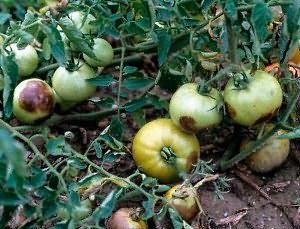
There is a whole list of late blight resistant varieties:
• Dwarf;
• Far North;
• Alaska;
• Snowdrop;
• Bullfinch;
• Rose of Wind;
• Snow fairy tale;
• Taimyr.
Even the name shows that all these varieties were bred for germination in non-hot climatic conditions. All these varieties perfectly tolerate transportation, which means they will be stored for a long time.
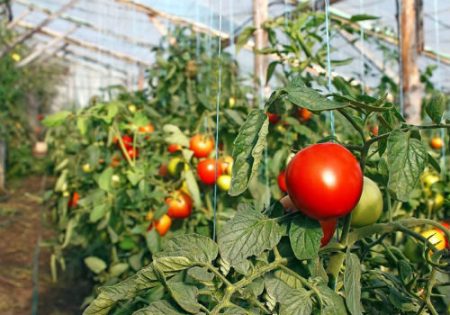
For gardeners, late blight is considered a sore subject. After all, planting tomatoes and caring for them, they put in a lot of energy. And when from the middle of summer they lose the crop grown by such hard work, they are very upset. The next year, they begin to think about which varieties are best planted and under what conditions to grow, so as not to be disappointed later. For this, gardeners must carry out the processing of plants from dark spots. This helps prevent the spread of the disease.
The latest varieties of tomatoes
Testing was conducted among 60 new varieties and 17 hybrids. "Novices" gave an excellent harvest and very tasty fruits. Now we list the particularly distinguished varieties that you can safely choose.
1. Among hybrids, “Silhouette” (6.5 kilograms from the bush) and “Minaret” (6.5 kilograms from the bush), “Malvasia” (5.7 kilograms), and “Berberana” (4.8 kilogram) and “Bugai” (4.1 kilograms), as well as “Palenka” (4.1 kilograms) and “Gualdino” (4 kilograms). Less than 4 kilograms of tomatoes were harvested from all the other bushes.
2. The variety "Bugai" was distinguished by the weight of the fruit. One brush reached a weight of up to 2 kilograms. The bushes themselves reached 2 meter high. In the Agegen variety, the fruits reached 500 grams, and in the Berberana hybrid - 650 grams.
3. Taste qualities were striking in two varieties: Melman and Geronimo. Also, delicious pink fruits were found in the varieties "Dimerosa", "Pink Claire".
4. Among black-fruited varieties, one can safely distinguish “Vorlon”, “Black Heart of Brad” and “Wine Pitcher”. Among this group, the highest-yielding variety can be distinguished variety "Violet pear Evans."
5. Of the domestic varieties, the “Best” and “Miracle of the Garden” can be distinguished. The fruits are significant in size, and the taste is simply incredible.
6. It is impossible not to note the beauty of the fruits of the variety “Madness Kasadi”. Tomatoes have a banana shape. From one bush you can collect up to 5 kilograms of fruit.
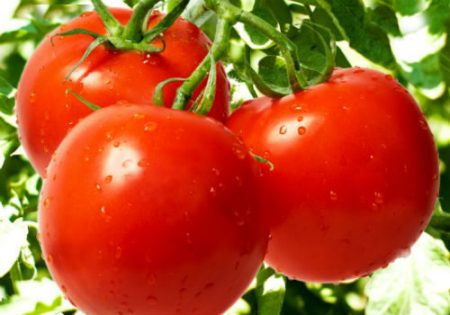
Tomatoes are most often susceptible to late blight. In order to somehow protect your shrubs, you need to carry out preventive measures. The most important thing is to choose the right seeds. Definitely, 100% resistant varieties do not exist, but there are plants with high resistance to this disease. We have already listed them above.
Important! Before buying seeds, read the instructions on the packaging. There in the description of the variety should be written: resistant to late blight. If you find this phrase, then you can safely buy seeds. Of course, this item does not always help protect the plant from the disease. It is best to read the reviews of experienced gardeners who grew different varieties and can share their experiences.
On the Internet you can find various forums where gardeners share tips. According to numerous reviews by amateur gardeners, we have identified the most resistant varieties of tomatoes.
These include:
• The little Prince;
• Oak;
• Grotto;
• White filling;
• Moscow lights;
• Berry;
• Orange heart.
From tall varieties distinguish:
• Orange miracle;
• Lark;
• Carotinka;
• Academician Sakharov;
• Tsar Peter.
Advice! For winter harvesting, it is better to choose varieties with solid fruits. Large NOT meaty tomatoes are suitable for creating tomato juice, and pink and yellow for salads.
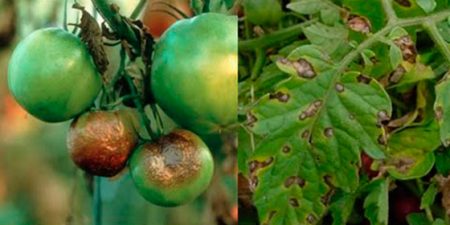
As you can see, there are a huge number of different varieties of tomatoes. When picking seeds, pay particular attention to what region the plant is intended for.
How to prevent late blight?
You can pre-arrange that the tomatoes on the beds do not get sick. Before sowing, seed treatment must be carried out with 1% potassium permanganate solution. Then, when the seeds will be transplanted already in the open ground, additionally treat the roots with “Bactofit”. You will understand how to carry out the processing along the way (you can read the instructions on the package).
Also, many gardeners use fungicides to protect plants. Such processing is started when the air temperature drops to 10 degrees. This usually happens in late July. You need to carry out a similar treatment every week.
Advice! There is a very good remedy for late blight - Bordeaux mixture. Every 2 weeks, tomatoes should be sprayed with a 1% solution before they begin to brown. 10 days before harvesting, processing should be discontinued.
Someone likes to process the treatment of copper oxychloride. It must be bred correctly (40 grams of the product goes to a bucket of water). One liter of solution takes up 10 square meters. 20 days before harvest, processing should be completed.
Among gardeners there are many who prefer to fight plant disease with folk methods. Based on practice, we can conclude that mustard, iodine and milk are considered the best folk remedies. Sometimes the roots of seedlings are required to be wrapped with copper wire. Greenhouse tomatoes need low humidity. Therefore, watering should be done in a special way (under the root).
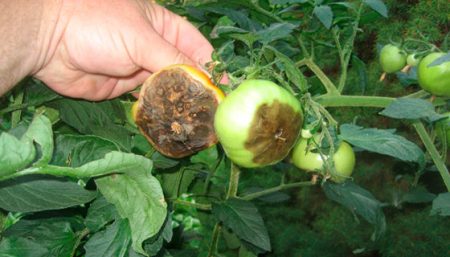
Attention! There is a very interesting way to water the plants under the root. Take a plastic bottle and make small holes around the circumference. When planting a plant, instill a bottle full of water. Water will gradually seep into the soil. When the bottle becomes empty, stocks can be replenished through the neck, which will be visible on the surface.
Also good for tomato is the neighborhood with mustard and basil. Moreover, fragrant grass is best planted with seedlings. When the mustard blooms, it must be pruned, which will help it bloom all season. Bacteria in the spores of the fungus will take away the iron and they will not wake up. Few people know, but basil gives tomatoes an extra charming taste and scares away worms.
Preventative measures
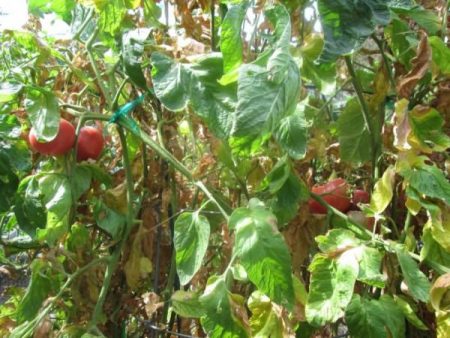 1. You need to take care of the plant's health from the very beginning. You yourself can protect the seeds from fungus in the soil and pathogens. To do this, you must first soak the seeds in a solution of manganese.
1. You need to take care of the plant's health from the very beginning. You yourself can protect the seeds from fungus in the soil and pathogens. To do this, you must first soak the seeds in a solution of manganese.
2. You can also try spraying the plant with a garlic compound. This treatment is carried out when a plant is formed. Take a bucket of water and dilute in it one glass of chopped garlic. Mix everything well. The solution should stand for a while. It is possible to spray with such structure several times a season.
3. You can prepare a slightly different solution. 100 grams of fresh yeast are dissolved in a bucket of water. Ready solution is sprayed with tomatoes.
4. Iodine treatment is very popular. Cooking it is not difficult. 40 drops of iodine solution are dissolved in one bucket of water. Mix everything well. Processing occurs during the growing season.
Recommended:Tomato Puzata hut: characteristics and description of the variety, photo
Whatever variety you plant for, remember that the main thing is what measures you will take in order to preserve the fruits. There is still no such plant that would be 100% resistant to late blight, but there are varieties that are extremely rare for diseases.Choose the best varieties, try, plant - perhaps you are lucky. After all, everything comes with experience! Good luck




 Low-growing tomatoes, without pinching: 5 of the most delicious varieties
Low-growing tomatoes, without pinching: 5 of the most delicious varieties Why tomato seedlings grow poorly
Why tomato seedlings grow poorly We grow a tomato in a shell
We grow a tomato in a shell Growing tomatoes without watering according to the method of Kazarin
Growing tomatoes without watering according to the method of Kazarin